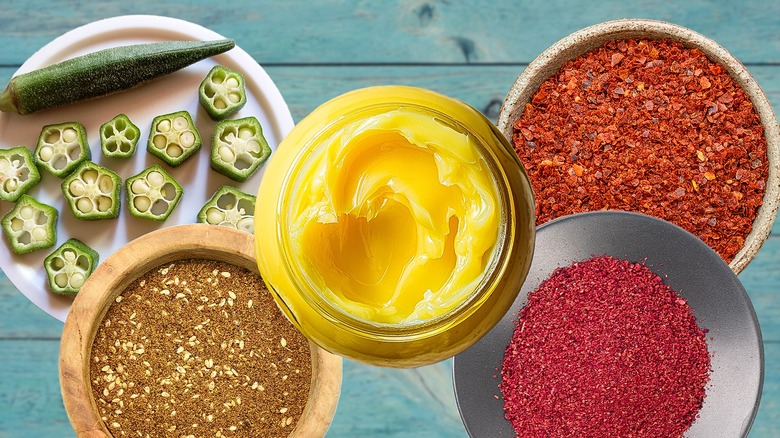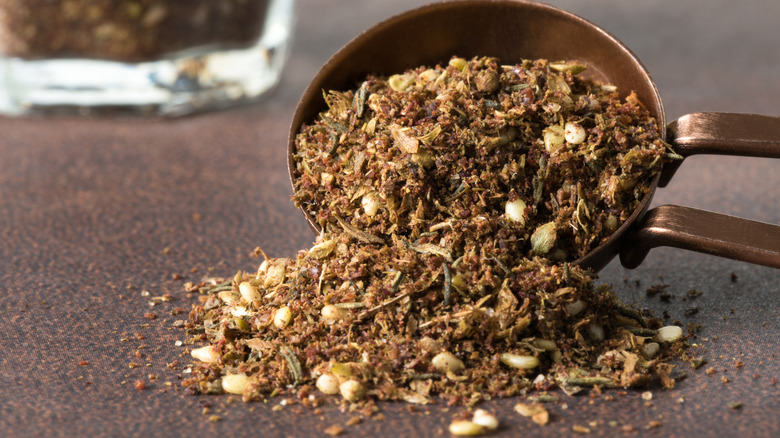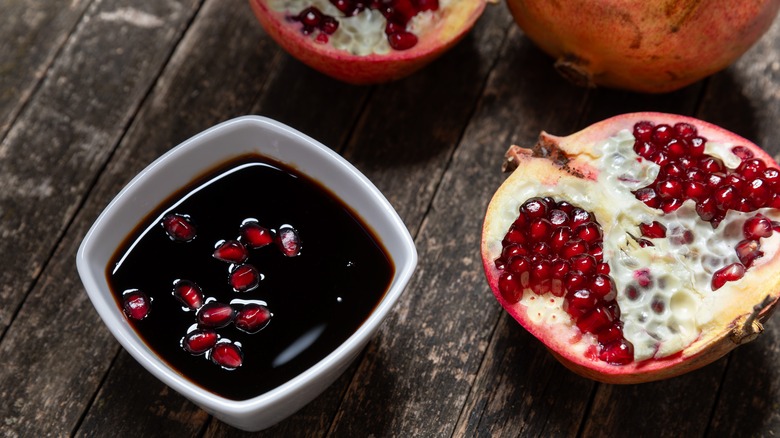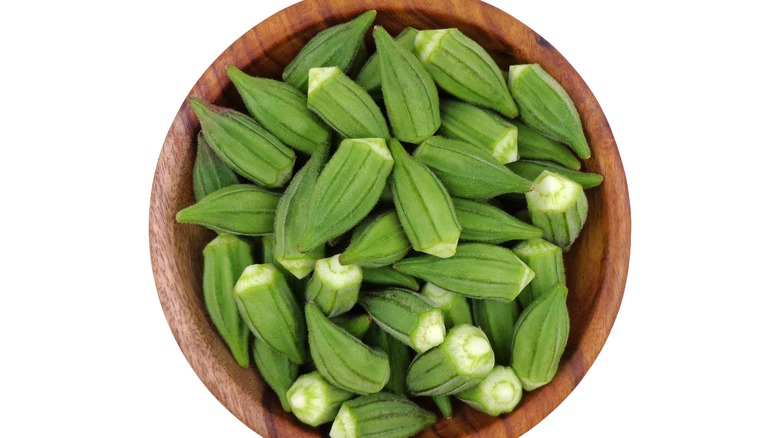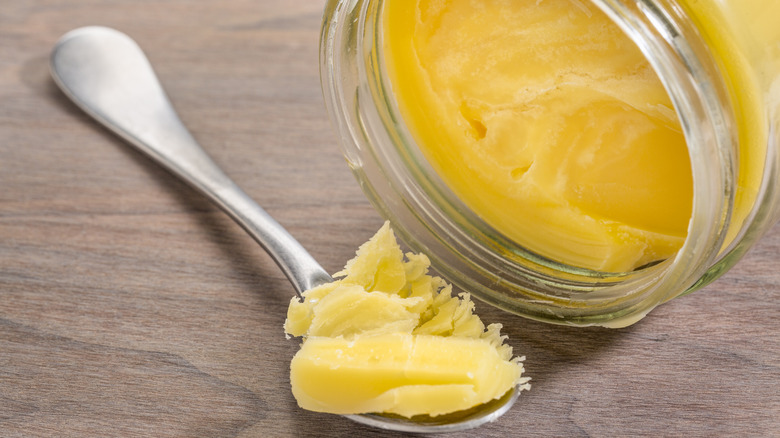13 Best Products To Buy At A Middle Eastern Grocery Store
There's an endless array of incredible Middle Eastern ingredients and foods, but you won't find many of them at the average U.S. grocery store. Even if you do, the items aren't always the best representatives of the region's ingredients or dishes. When you're looking for genuine variety and authenticity, your best bet is to visit a Middle Eastern grocery store instead.
Growing up as an Egyptian immigrant, my family and I often sought out Middle Eastern grocery stores that offered a wide range of authentic regional food products. There are so many goodies to find and enhance your pantry from these specialty stores, including spices, condiments, coffees, and more. Many Middle Eastern grocery stores have a refrigerated or frozen section, too, and some even offer homemade treats, snacks, and prepared foods, as well. Now, while my family had to occasionally travel to another city to track down our favorite comfort items in the past, there's much more access to Middle Eastern food in the 2020s.
If you're wondering which food items are worth seeking out from the nearest specialty store, I've got the answers. Between my personal experience and professional expertise as a recipe developer and food writer, I'm extremely well-acquainted with which Middle Eastern food items are worth purchasing from these stores. Here are the best (and some of my personal go-to) products to buy at a Middle Eastern grocery store.
Za'atar
If you haven't yet heard of za'atar, you may soon become obsessed with this Middle Eastern condiment. The tasty herb and spice mix is used all over the Levant on foods like flatbreads (called manakish), salads, eggs, or served simply with bread and olive oil for dipping. It's savory, earthy, nutty, and tangy all in one, with ingredients that provide a well-rounded flavor. Since there are so many ways to use za'atar – and you can get as creative as you want when cooking with it – be sure to buy it when visiting a Middle Eastern grocery store.
Now, you may be able to find za'atar at a mainstream supermarket, but not all za'atar blends are equal. These blends aren't always made with the right herbs or highest quality ingredients, after all, so it's worth visiting a Middle Eastern grocery store to grab a packet or jar of authentic za'atar. Plus, if you're unsure what to get, you can always ask someone at the store to guide you to a za'atar you're apt to enjoy.
Pomegranate molasses
If you're wondering what pomegranate molasses is, well, it's exactly what it sounds like. This ruby red liquid is fruity, tart, a tiny bit sweet, and can add just enough brightness to lift any dish to new heights. Different brands may have different recipes, but at its heart, it's a concentration of pomegranate juice and sugar that's been cooked down to a syrup. Since pomegranates are a notoriously tricky fruit to prepare, most people prefer to buy their pomegranate molasses ready-made.
Pomegranate molasses is a pantry staple in the Middle East, and its various uses in regional cuisine highlight its versatility. It's the main salad dressing ingredient for many vinaigrettes, used in meat dishes, dips, and in sausages, as well. Perhaps it's surprising that pomegranate molasses is mainly used in savory dishes, but it truly works well and often adds the right balance. You can find it at any Middle Eastern grocery store, with varying degrees of sweetness and natural ingredients. You can use this Middle Eastern product to glaze salmon or in exciting cocktails like a pomegranate gin fizz.
Labneh
One Middle Eastern food item that's quite tricky to find in your run-of-the-mill grocery store is labneh. With that in mind, if you love this creamy white cheese, it's well worth a trip to a Middle Eastern grocery store to buy some.
Labneh is somewhere between Greek yogurt and cheese, and is usually made by straining yogurt from its whey to create a thicker product. It lends itself beautifully to savory foods, but you can eat it sweet with some honey or fruit compote, too. You'll find labneh in the refrigerated section, and depending on the size of the store, you might find a variety of different types, as well.
There's usually spreadable cartons, larger jars, or labneh balls with different toppings like nigella seeds, za'atar, chili powder, or mint (among others). If you're new to labneh, get yourself a spread. It's so easy to use, and a little dollop on some pita bread, toast or a cracker will convert you to a labneh lover instantly.
Sumac
One aspect of Middle Eastern cuisine that's widely known is how spice-rich it is. Most dishes — whether savory or sweet — are spiced and seasoned in ways that range from subtle to pungent. While warmer spices (such as cinnamon, coriander, cumin, and cardamom) are more well-known, the surprisingly tart and bright red-hued spice called sumac is just as important.
Though it's been gaining popularity in Western kitchens, sumac has been loved across West Asia, Turkey, and Iran since ancient times. It comes from the berry of the sumac plant, which is dried and ground to a powder — hence its deep crimson color and fruity, sour taste. You might know it as one of the components of za'atar, but on its own, the spice has a wonderful flavor worthy of being the center of attention.
Sumac is often sprinkled on salads, dips, and rice, and can be used to season grilled chicken or fish. You can also make it a part of your avocado toast lunch, add it to your yogurt, or even use the vibrant spice to give shortbread cookies a tart bite.
Arabic coffee
If you're a coffee enthusiast who's never tried Arabic or Turkish coffee (the catch-all terms for coffee across the Middle East), then you're doing something wrong. The beverage has played a rich part in the region's cultural heritage, after all, and it's worth visiting a Middle Eastern grocery for the coffee alone.
You'll smell it before you see it: The rich aroma of coffee guiding you to the colorful bags of ground beans that are sold both spiced and unspiced. Spiced coffee usually contains a hint of cardamom, and perhaps some mastic or cloves, which is the traditional taste of coffee from this region. If you don't know where to start, Cafe Najjar is a quality brand that yields a strong but smooth cup of coffee. It's got enough kick to give you a caffeine buzz without leaving you feeling wired and goes well after a meal (the added cardamom is believed to be good for digestion).
For anyone looking to make Arabic or Turkish coffee the traditional way, consider buying a small copper coffee pot called a briki (it has other names, as well). These can also be found in Middle Eastern grocery stores and are often fairly affordable. You can use it on a stovetop, taking just a couple of minutes to freshly brew one or two cups of coffee.
Pickled vegetables
From North Africa to West Asia, there's rarely a table spread without a plate of pickled vegetables. Though these pickles are merely a side character to the main course, they're as ubiquitous (and important) as any other dish. Coming in a variety of colors and flavors, Middle Eastern pickled vegetables are often used to break through a fatty meal or wrapped in shawarma for a hit of crunchy sharpness. Since you're unlikely to ever see these types of pickled vegetables in a mainstream supermarket, it's worth buying them from a Middle Eastern grocery store.
One of the best kept secrets of Middle Eastern cuisine, there are so many pickled vegetable variations. They're crispier and saltier than average pickles, and sometimes spicier, too. You can find anything from pickled turnips, carrots, cabbages, chiles, olives, cucumbers, cauliflower, onions, and even lemons. You can find jars with an assortment of pickles, as well.
Traditional Arabic bread
One of my favorite things to buy at a Middle Eastern grocery store is a packet of the fascinating ancient bread known as pita. This traditional Arabic bread comes with many different names depending on the store and region. But whether it's called Syrian, Lebanese, or simply traditional bread, it's a type of flatbread that's typically large, round, and thin. It's perfect for filling with your favorite shawarma, beans, or falafel. I love to use it instead of wraps, and you can add labneh, roll the bread up, and enjoy it at any time of the day, as well.
Traditional Arabic bread is great as is, but you can also toast it with some olive oil and za'atar to make your own tasty manousheh for breakfast (or a midday snack). Plus, it freezes really well, so you place an entire package in the freezer and warm them up one by one as needed. Some Middle Eastern stores might sell different types of bread, like semolina-based Algerian or Moroccan breads, or wholewheat pitas such as Egyptian traditional breads. It's worth a look to see what's in store and try different ones.
Sesame seeds and tahini
If you cook and bake with sesame seeds, it's useful to buy a larger amount than the tiny jars or packets sold at most grocery stores. Considering how integral sesame seeds are to many Middle Eastern dishes, you can often find bigger batches of them at specialty grocery stores — and usually at lower prices.
Sesame seeds generally keep for a long time, but to keep them extra fresh, you can keep them in your freezer. Of course, another sesame seed product that you can find for a good price at Middle Eastern grocery stores is tahini — AKA pure sesame seed paste sold in various sizes and brands. You'll likely find tahini sold at regular stores with added ingredients, but this won't be as tasty as an authentic version. Given this, it's best to go for a jar containing just sesame seed paste from a specialty location, then mix your own sauces at home.
You can buy this nutty ingredient and use it as the base for all types of sauces and dressings. Tahini can make anything creamy without the need for dairy, too; try some in your next banana smoothie and taste how luscious it can be.
Okra
This may be one of the most controversial vegetables out there. But for people who aren't averse to the slime, okra is a great ingredient — and an extremely versatile one, too. Plus, there are ways to decrease the slime (or embrace it, if you prefer). You can roast it, deep-fry it, add it to soups and stews, or blend it into smoothies. Since Middle Eastern cuisine has a couple of well-loved okra dishes, as well, you'll always find the vegetable at a Middle Eastern grocery store.
If you can't find the fresh veggie, you'll almost certainly find frozen okra in the freezer section. There, you'll also find "okra zero" — or a baby okra that's become really popular in Middle Eastern cooking because of how tender and flavorful it is. This type of okra is no bigger than your thumb and incredibly easy to cook with. If you've never tried okra, try cooking with these and you may be pleasantly surprised.
Aleppo pepper
You may find yourself in the spice section of a Middle Eastern grocery store for longer than intended. After all, the blends and aromas will likely make you want to investigate them all. I particularly seek out chile and pepper spices because there's usually more variety than just one or two non-descript "chile powder" or "pepper spice" options. You'll find spices like Turkish urfa biber at Middle Eastern stores, as well as Aleppo pepper, which is worth buying when you're there.
Aleppo pepper is sometimes labeled halaby pepper — "halab" means Aleppo in Arabic — and is named after Aleppo, Syria (where this style of pepper originates). Aleppo pepper is different from regular chile flakes in that it's not as hot, with fruity and smoky undertones that make it a flavor enhancer. Since Aleppo pepper is just as integral as salt and pepper in some parts of the Middle East, you'll always find it at a specialty grocery store.
Dates and date syrup
Growing up in a Middle Eastern household, dates were always present. My mother would even occasionally make a date butter, creating a magnificent and smooth mixture to spread on bread. This made trips to a Middle Eastern grocery store essential, as these businesses always have a good stock of dates with different varieties.
If you have a sweet tooth, you may already love dates. These sticky, gooey dried fruits can satisfy even the most extreme craving for something sweet. You can pop them in smoothies as a natural sugar source, use them to bake all kinds of delicious treats, wrap them, stuff them, or eat them as is.
Beyond the fruit itself, another incredible date product you should buy is date syrup or molasses. This dark, sweet syrup is made from dates and has an earthy caramel flavor. It goes well on anything you'd add syrup to, including pancakes, oatmeal, and more. You'll find date syrup on the shelf at any Middle Eastern grocery store, usually near similar products such as pomegranate molasses.
Ghee
Ghee — or "samna" as it's known in Arabic — is essential in Middle Eastern cuisine. It's not an ingredient you just swap out for butter or oil, either, since its flavor is often what an entire dish is built on. From sweet bakes to savory dishes, there are so many great ways to use ghee. It's a useful ingredient to keep in your kitchen for any type of cuisine and instantly enhances your cooking with a richer, more intensely buttery flavor — meaning it's worth buying from Middle Eastern grocery stores.
This clarified butter is possible to make yourself, and my family used to make our own ghee because we couldn't find it in stores. However, when we did manage to find ghee at a Middle Eastern grocery store, it was a must buy to save ourselves the trouble of the making it at home. Stores often stock different brands of ghee, and can be found in large bulk tins, as well as smaller cans if you just want to give it a try first.
Shawarma spice
It's hard to find someone who doesn't love shawarma — and it's the spices that arguably make the dish. Now, shawarma spice is a broad term for a blend of spices that includes everything from cumin, coriander, cinnamon, cloves, and nutmeg (to name a few). It's a complex seasoning that works with any type of grilled meat or roasted chicken; I'll even use shawarma spice on roasted tofu to make a vegan shawarma that rivals the meaty version. Consequently, whenever I visit a Middle Eastern grocery store, I'm sure to get a jar or packet — and you should, too.
Buying shawarma spice from a specialty store saves the trouble of adding each individual spice to whatever you're cooking (or researching what goes into the spice mix and making your own blend). If you can't find shawarma spice specifically, you'll definitely find something called "Lebanese seven spice" which is the blend that shawarma spice is based on. This all-purpose Lebanese spice blend can be used for shawarma and other dishes like kofta (and more). Adding 1 or 2 teaspoons of this spice mixture is the easiest way to make a fragrant and tasty dish.
